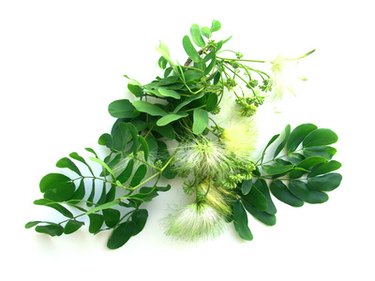
Acacia is not a cactus, but it is prickly. It is a member of a large genus that is drought resistant, thorned and native to arid zones. Acacia grows as a bush or a tree and is found across the deserts in the southwest United States. Acacia requires temperatures that exceed 64 degrees Fahrenheit. It produces clusters of sweet smelling flowers that attract pollinators. The lacy foliage and shape of the tree make it an excellent addition to the warm season landscape.
Leaves
Video of the Day
The leaves of the acacia are alternate and pinnated. The individual leaflets form a feather shape. The acacia leaves will drop when confronted with severe drought. This protective adaptation is called semi-deciduous. The loss of leaves prevents evaporation and slows plant growth. This conserves moisture and plant energy until rains come and then the plant can resume growth. This is also a common desert plant adaptation where they will cease growth until resources are available.
Video of the Day
Ants
Ants colonize acacia and feed on the sweet sap. In return they protect the tree from predators. The acacia tree has thorns which are a useful adaptation to prevent grazing, but giraffe's long tongues are not bothered by the thorns. The ants will attack any insect invaders but will also swarm over the giraffe's lips and tongue and repel the herbivore. Acacia flowers emit chemicals that repel ants.
Pods
After the flowers are spent, the acacia forms seed pods or fruits. They are dry, long capsules. The pods stay on the tree for some time and drop when conditions are favorable. The heavy, thick pod protects the seeds and the advantageous germination only occurs when the rainy season appears. This allows the seedling the best chance of surviving. Temperatures need to be above 45 degrees Fahrenheit and there must be at least 1.2 inches of rainfall to initiate germination.
Fire
Acacia have remarkable resistance to fire. Desert prairies are extremely arid, and lightning strikes cause fire to flare and race across the land. Acacia quickly re-sprouts from the roots following top-kill in a fire. This rapid recovery is essential for the desert or chaparral habitat. It is also important for the plant because fire controls non-native species. The burns are beneficial for fire resistant species by burning out competing shrubs.
- Federal United States Forest Service: Acacia Greggii
- Think Quest: Biomes- Plant Adaptations
- British Broadcasting Company: Adaptations of Plants and Animals
- University of Las Vegas Arizona: Adaptations of Plants to Arid Environments
- British Broadcasting Company News: Acacia Plants Control Ants with Chemicals
- Acacia Plant: Acacia